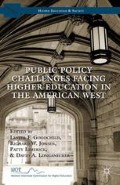Abstract
The western states have unique geographical challenges compared to the rest of the United States. Vast spaces and very small communities of people contributed to making colleges and universities in the West among the first to adopt technological solutions for reaching people. Since the mid-1980s, Alaska, California, Colorado, Hawaii, North Dakota, South Dakota, Washington, and Utah have played a leading role in developing technological and/or administrative systems to serve students who were not able to come to a campus.
Sally Johnstone wishes to thank the early WCET staff members who facilitated the progression of quality distance learning practices and policies, Mollie McGill and Russ Poulin. More thanks go to Paul Albright for documenting western higher education progress.
Ritchie Boyd would like to thank Bob Gillespie, Dan Jordt, and Marty Ringle for their lively discussions of the history of NorthWestNet and the future of academic computing. In addition, thanks go to Russ Poulin and Mike Offerman for their reflections on emerging educational consortia and companies in the West.
Access this chapter
Tax calculation will be finalised at checkout
Purchases are for personal use only
Preview
Unable to display preview. Download preview PDF.
References
Atkins, D. E., J. S. Brown, and A. L. Hammond. A Review of the Open Educational Resources (OER) Movement: Achievements, Challenges, and New Opportunities. Retrieved from www.oerderves.org/wp-content/uploads/2007/03/a%20review-of%20-the-open-educational-resources-oer-movement_%20final.pdf,%202007, in January 2009.
Boyd, D. Social Network Sites: Public, Private or What? Retrieved from The Knowledge Tree http://kt.flexiblelearning.net.au/tkt2007/edition-13/social-network-sites-public-private-or-what/, 2007, in September 2008.
Dirr, P. Putting Principles into Practice: Promoting Effective Support Services for Students in Distance Learning Programs: A Report on the Findings of a Survey. Retrieved from www.wiche.edu/wcet/Resources/publications/index.htm, 1999.
Epper, R., and M. Garn. Virtual College and University Consortia, A National Study. Retrieved from www.wcet.info/resources/publications/vcu.pdf, 2003, in December 2004.
Johnstone, S. M. “Open Educational Resources.” Proceedings of the First Global Forum on Quality Assurance, Accreditation and Recognition of Qualification. United Nations Educational Scientific and Cultural Organization, 2002.
Johnstone, S. M. “Signs of the Times: Change is Coming for E-Learning.” Educause Review, Nov/Dec (2002): 15–24.
Johnstone, S. M. “Quality Issues in Electronic Delivery of Higher Education,” Journal for Public Service and Outreach, 2 (3) (1997): 12–17.
Johnstone, S. M., and Connick, G. (eds.). The Distance Learner’s Guide, 2nd ed. Upper Saddle River, NJ: Prentice Hall, 2005.
Johnstone, S. M., and D. Jones. “New Higher Education Trends Reflected in the Design of the Western Governors University,” On the Horizon (1997).
Johnstone, S. M., and R. Poulin. “So, How Much Do Technologies Really Cost?” Change, 34 (2) (2002): 21–23.
Jones, D. P. Technology Costing Methodology Handbook—Version 1.0, Western Interstate Commission for Higher Education. Retrieved from www.wiche.edu/telecom/projects/tcm/TCM_Handbook_Final.pdf, 2001.
National Center for Educational Statistics. Distance Education at Postsecondary Education Institutions. US Department of Education, OERI Publication #2000–013, NCES, 1999.
Tapscott, D., and A. Williams. Wikinomics: How Mass Collaboration Changes Everything. New York, Portfolio, 2006.
Trombley, W. “Electronic Education,” CrossTalk (California Higher Education Policy Center) 4 (3) (1969): 1, 12.
Western Cooperative for Educational Telecommunications. “WCET Announces Awards for Outstanding Work in Using Technology for Education” (press release). Retrieved from www.wcet.info/%20documents/WOWAwardsPressRelease2004.asp, 2004, in January 2009.
Western Cooperative for Educational Telecommunications. When Distance Education Crosses State Boundaries: Western States’ Policies. Boulder, CO: Western Interstate Commission for Higher Education, 1995.
Editor information
Copyright information
© 2014 Lester F. Goodchild, Richard W. Jonsen, Patty Limerick, and David A. Longanecker
About this chapter
Cite this chapter
Johnstone, S.M., Boyd, J.R. (2014). Technology and Distance Education: Challenges Facing the American West. In: Goodchild, L.F., Jonsen, R.W., Limerick, P., Longanecker, D.A. (eds) Public Policy Challenges Facing Higher Education in the American West. Higher Education & Society. Palgrave Macmillan, New York. https://doi.org/10.1057/9781137403780_7
Download citation
DOI: https://doi.org/10.1057/9781137403780_7
Publisher Name: Palgrave Macmillan, New York
Print ISBN: 978-1-349-47982-5
Online ISBN: 978-1-137-40378-0
eBook Packages: Palgrave Education CollectionEducation (R0)

